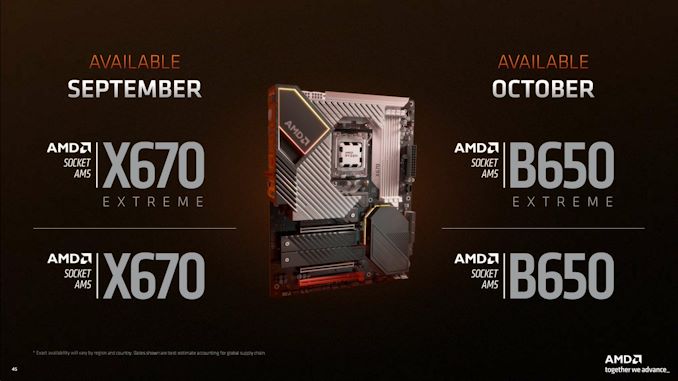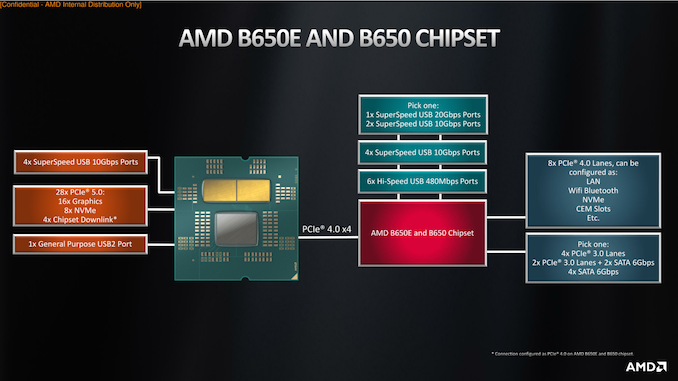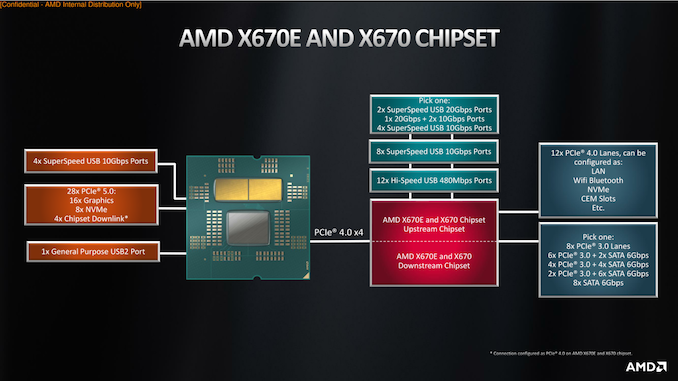AMD Zen 4 Ryzen 9 7950X and Ryzen 5 7600X Review: Retaking The High-End
by Ryan Smith & Gavin Bonshor on September 26, 2022 9:00 AM ESTAM5 Chipsets: X670 and B650, Built by ASMedia
Finally, let’s talk about the chipsets that are going to be driving the new AM5 platform. Kicking things off, we have the B650 and X670 chipsets, as well as their Extreme variations. Since AMD is starting the rollout of their new platform with their high-end CPUs, they are matching this with the rollout of their high-end chipsets.
For this week’s launch, the initial boards available are all from the X670 family. B650 boards will, in turn, be coming next month. We’ll break down the difference between the two families below, but at a high level, X670 offers more I/O options than B650. And while not strictly a feature of the chipset, the market segmentation is such that the bulk of high-end AM5 boards – those boards with a massive amount of VRMs and other overclocker/tweaker-friendly features – will be X670 boards.
That said, for simplicity’s sake we’re going to start with the B650 chipset, and build up from there.
| AMD AM5 Chipset Comparison | ||||
| Feature | X670E | X670 | B650E | B650 |
| CPU PCIe (PCIe) | 5.0 (Essentially Mandatory) | 4.0 (5.0 Optional) |
5.0 (Essentially Mandatory) | 4.0 (5.0 Optional) |
| CPU PCIe (M.2 Slots) | At Least 1 PCIe 5.0 Slot | |||
| Total CPU PCIe Lanes | 24 | |||
| Max Chipset PCIe Lanes | 12x 4.0 + 8x 3.0 | 8x 4.0 + 4x 3.0 | ||
| SuperSpeed 10Gbps USB Ports | 4 CPU + 12 Chipset or 4 CPU + 10 Chipset + 1 Chipset 20Gbps or 4 CPU + 8 Chipset + 2 Chipset 20Gbps |
4 CPU + 6 Chipset |
||
| DDR5 Support | Quad Channel (128-bit bus) Speeds TBD |
|||
| Wi-Fi 6E | Yes | |||
| CPU Overclocking Support | Y | Y | Y | Y |
| Memory Overclocking Support | Y | Y | Y | Y |
| Available | September 2022 | October 2022 | ||
B650, AMD’s mainstream AM5 chipset, can best be thought of as a PCIe 4.0 switch with a bunch of additional I/O baked in. And as is typical for chipsets these days, several of the I/O lanes coming from the chipset are flexible lanes that can be reallocated between various protocols. Meanwhile, uplink to the CPU is a PCIe 4.0 x4 connection.
For PCIe connectivity, B650 offers 8 PCIe 4.0 lanes, which can either have PCIe slots or further integrated peripherals (LAN, Wi-Fi, etc) hung off of them. This and the uplink speed are both notable improvements over the B550 chipset, which was PCIe 3.0 throughout, despite Ryzen 3000/5000 offering PCIe 4.0 connectivity. So B650 has a lot more bandwidth coming into it, and available to distribute to peripherals.
There are also a quartet of PCIe 3.0 lanes which are shared with the SATA ports, allowing for either 4 PCIe lanes, 2 lanes + 2 SATA, or 4 SATA ports. Notably, the dedicated SATA ports found on the 500 series chipsets are gone, so motherboards will always have to sacrifice PCIe lanes to enable SATA ports. For the B650 this amounts to a net loss of 2 SATA ports, as the most ports it can drive without a discrete storage controller is 4.
Meanwhile on the USB front, motherboard vendors get more Superspeed USB ports than before. The chipset offers a fixed 4 10Gbps Superspeed ports, and then an additional output can be configured as either a single 20Gbps (2x2) port, or two 10Gbps ports. Finally, the chipset can drive a further 6 USB 2 ports, mostly for on-board peripheral use. There are no USB root ports limited to 5Gbps here, so all USB 3.x ports, whether coming from the CPU or the chipset, are capable of 10Gbps operation.
AMD has once again outsourced chipset development for this generation to ASMedia, who also designed the B550 chipset. AMD has not disclosed a TDP for the chipset, but like B550 before it, it is designed to run with passive cooling.
Outside of the technical capabilities of the B650 chipset itself, AMD is also imposing some feature requirements on motherboard makers as part of the overall AM5 platform, and this is where the Extreme designation comes in. All B650 (and X670) motherboards must support at least 1 PCIe 5.0 x4 connection for storage; Raphael has enough lanes to drive two storage devices at those speeds, but it will be up to motherboard manufacturers if they want to actually run at those speeds (given the difficulty of PCIe 5.0 routing).
Extreme motherboards, in turn, will also require that PCIe 5.0 is supported to at least one PCIe slot – normally, the x16 PCIe Graphics (PEG) slot. Non-extreme motherboards will not require this, and while motherboard vendors could technically do it anyhow, it would defeat the purpose of (and higher margins afforded by) the Extreme branding. Conversely, while AMD has been careful to toe a line about calling 5.0 slots outright mandatory on Extreme motherboards, it’s clear that there’s some kind of licensing or validation program in place where motherboard makers would be driving up their costs for no good reason if they tried to make an Extreme board without 5.0 slots.
It’s frankly more confusing than it should be, owing to a lack of hard and definite rules set by AMD; but the messaging from AMD is that it shouldn’t be a real issue, and that if you see an Extreme motherboard, it will offer PCIe 5.0 to its graphics slot. Past that, offering 5.0 to additional slots, bifurcation support, etc is up to motherboard vendors. The more PCIe 5.0 slots they enable, the more expensive boards are going to be.
Meanwhile the high-end counterpart to the B650 chipset is the X670 chipset, which is pretty much just two B650 chipsets on a single board. While not explicitly confirmed by AMD, as we’ll see in the logical diagram for X670, there’s no way to escape the conclusion that X670 is just using B650 dies daisy chained off of one another to add more I/O lanes.
Officially, X670 is a two-chip solution, using what AMD terms the “downstream” and “upstream” chipsets. The upstream chip is connected to the CPU via a PCIe 4.0 x4 connection, and meanwhile the downstream chip is connected to the upstream chip via another PCIe 4.0 x4 connection.
By doubling up on the number of chips on board, the number of I/O lanes and options are virtually doubled. The sum total of the two chips offers up to 12 PCIe 4.0 lanes (the last 4 are consumed by the upstream chip feeding the downstream chip) and a further 8 PCIe 3.0 lanes that can be shifted between PCIe and up to 8 SATA ports.
Meanwhile on the USB front, there are now 8 fixed USB 2 ports and 8 fixed SuperSpeed USB 10Gbps ports. For USB flex I/O, motherboard makers can select from either 2 20Gbps ports, 1 20Gbps port plus 2 10Gbps ports, or 4 10Gbps ports.
And while this configuration adds more I/O lanes (and thus more I/O bandwidth), it should be noted that all of these I/O lanes are still gated behind the PCIe 4.0 x4 connection going back to the CPU. So the amount of backhaul bandwidth available between the chipsets and the CPU is not any higher than it is on B650. The name of the game here is flexibility; AMD is not designing this platform for lots of sustained, high-speed I/O outside of the CPU-connected x16 PCIe graphics slot and M.2 slots. Rather, it’s designed to have a lot of peripherals attached that are either low bandwidth, or only periodically need high bandwidths. If you need significantly more sustained I/O bandwidth, then in AMD’s ecosystem there is a very clear push towards Threadripper Pro products.
Finally, X670 Extreme (X670E) will impose the same PCIe 5.0 requirements as B650E. This means Extreme boards will offer PCIe 5.0 connectivity for at least one PCIe lane, while X670 boards are expected to come with just PCIe 4.0 slots. These will be the most expensive boards, owing to a combination of requiring two chipsets, as well as the extra costs and redrivers that go into extending PCIe 5.0 farther throughout a motherboard.
On that note, when discussing the new chipsets with AMD, the company did offer an explanation for why X670 daisy chains the chipsets. In short, daisy chaining allows for additional routing – the downstream chipset can be placed relative to the upstream chipset, instead of relative to the CPU (and PCIe devices then placed relative to the chipsets). In other words, this allows for spreading out I/O so that it’s not all so close to the CPU, making better use of the full (E)ATX board. As well, hanging both chipsets off of the CPU would consume another 4 PCIe lanes, which AMD would rather see going to additional storage.













205 Comments
View All Comments
AndrewJacksonZA - Monday, September 26, 2022 - link
I would imagine it's a technically correct way of saying that it's certified for Windows 11. See here about the TPM:www DOT microsoft DOT com/security/blog/2020/11/17/meet-the-microsoft-pluton-processor-the-security-chip-designed-for-the-future-of-windows-pcs/ Reply
socket420 - Monday, September 26, 2022 - link
I'm primarily asking whether or not the Pluton security coprocessor has been incorporated into Raphael/Ryzen 7000 CPUs, and I'm pretty sure that isn't what they were implying - Microsoft *does* have a "secured-core PC" baseline for Win11 they've been pushing lately, but it's currently unclear how Pluton ties into that so I don't think Win11 "certification" has anything to do with it. Pluton wasn't mentioned in AMD's desktop Ryzen 7000 press release last month, I didn't see it in any of the Zen 4 architectural slides they showed off today and AnandTech is the only outlet that's brought it up at all, which is why I'm asking this question in the first place - AMD hasn't been particularly forthcoming about the subject and I feel like they would've mentioned Pluton in a press release if it was actually present in these chips. ReplyRyan Smith - Monday, September 26, 2022 - link
I am not privy to the implementation details. But like other parts of the IOD, Pluton is inherited from the Ryzen 6000 Mobile parts. So it has the same Pluton implementation as those mobile chips.TL;DR: I don't know how they're technically accomplishing it, but yes, Pluton is there and enabled. Reply
socket420 - Tuesday, September 27, 2022 - link
Thanks for the response. Just to clarify, if I reread that section correctly, the Ryzen 7000 I/O die is a new design that had most of the additions from Ryzen 6000 ported over to it, Pluton included. That sounds incredibly damning, but I'm not sure how it's possible to confirm its presence without implementation details. I'm also unsure why AMD would brag about Pluton being present in two different mobile CPU releases from the moment they were announced while seemingly ignoring it in their new and shiny desktop Ryzen lineup up until its release date (are they hoping we won't notice?), but then again, it's been months since Ryzen 6000 was launched and no one's taken a closer look at its Pluton implementation yet, so :/IIRC, Lenovo ships their Ryzen 6000 Thinkpads with Pluton disabled and you have to go into their BIOS to toggle it on or off, so maybe that option showing up on consumer AM5 boards will show us if Pluton's there or not? It'd also be cool if someone asked AMD directly for a response, but Robert Hallock said he "didn't know" if Pluton was in Zen 4 and he coincidentally just left the company, so I have no idea who to reach out to. Reply
Silver5urfer - Tuesday, September 27, 2022 - link
Thanks for your question and this new garbage Pluton cancer is what I did not want to see shame how they added it. ReplyOxford Guy - Tuesday, September 27, 2022 - link
You will own nothing and be owned by everything. You will be happy. ReplyValantar - Monday, September 26, 2022 - link
Could you please run your per-core power draw tests for these chips like you did for Zen3? Replytakling1986 - Monday, September 26, 2022 - link
I think this review is "streets ahead". ReplyIBM760XL - Monday, September 26, 2022 - link
All right, since they aren't read yet, I'll ask... is it easy to set a lower TDP limit, and could you examine power efficiency when the TDP is the same as it was for Ryzen 5000?Looking at the numbers Tom's Hardware posted, the 7950X uses about 80W more at load than the 5950X. With AMD's own slides touting the efficiency improvements being greater at lower TDPs, what I'd really like is to have an octo-core at 65W like the 5700, or perhaps a 12/16 core at 105W like the 5900/5950.
Though I'm very likely to wait until B650 drops before making a decision, so there's plenty of time for an answer to that question to arrive. Reply
abufrejoval - Wednesday, September 28, 2022 - link
I can only guess that it should be trival to do via RyzenMaster, just in case it's not supported in the BIOS. And of course I'd demand CLI tools for both Linux and Windows.I cannot imagine that with a max TDP of 140 Watts a 7950X won't still be faster than a 5950X, even if it won't be quite as fast as if you let it drain the bottle at full hilt. The typical CMOS knee will still be there, only moved forward a bit and with a lot more of a "hot leg" showing towards the top.
But gains per clock and Watt will be terrible the higher you go on the "hot leg" by nature of silicon physics and any sensible person will just use a "lesser cooler" to avoid that nonsense. Reply